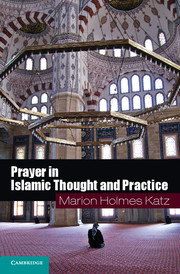1 - Canonical prayer (ṣalāt) and supplication (duʿāʾ)
Development and rules
Published online by Cambridge University Press: 05 April 2013
Summary
What did the word ṣalāt mean in Arabic before the revelation of the Qurʾān, and was it in origin Arabic at all? Was the ritual (or its components) already familiar in pre-Islamic Arabia? What might it have meant to contemporary observers? As noted by Gerhard Böwering, the Qurʾān appears to assume that the word requires no explanation. The Qurʾān also gives ṣalāt an ancient pedigree, using the word to refer to the forms of prayer that were performed and commanded by previous prophets. Prayer – including physical prostration – is represented as a prophetic heritage going back to the beginnings of the human race. Verses 19:58–9 associate prostration and ṣalāt with the descendants of Adam, Noah, and Abraham. In some passages it is particularly associated with the line of Abraham, who beseeches in verse 14:40, “O Lord! Make me one who establishes regular prayer (yuqīm al-ṣalāt), and also [raise such] among my offspring.” Ishmael is described (verse 19:55) as one “who used to enjoin on his people prayer and charity,” and Isaac and Jacob were inspired by God “to do good deeds, to establish regular prayers, and to practice regular charity” (21:73). Ritual prayer is also associated with the Jewish and Christian communities; verse 98:5 affirms of the People of the Book, “They have been commanded no more than this: To worship God, offering Him sincere devotion, being true [in faith]; to establish regular prayer, and to practice regular charity.” Despite the strong thematic connection between ṣalāt and Abrahamic monotheism, however, in the Qurʾān ritual prayer is not associated exclusively with Abrahamic figures; in verse 31:17 the Arabian sage Luqmān counsels his son to “establish regular prayer, enjoin what is just, and forbid what is wrong.”
- Type
- Chapter
- Information
- Prayer in Islamic Thought and Practice , pp. 10 - 43Publisher: Cambridge University PressPrint publication year: 2013



